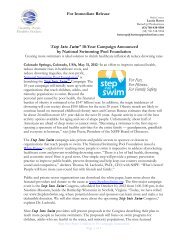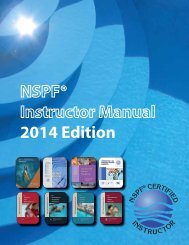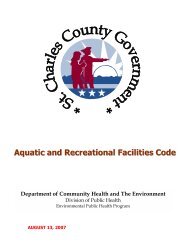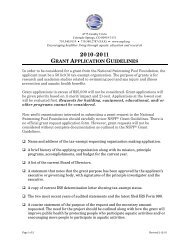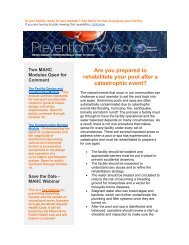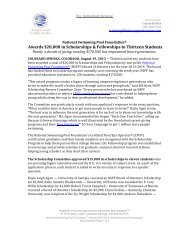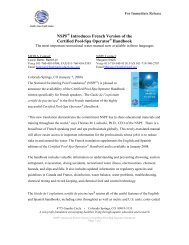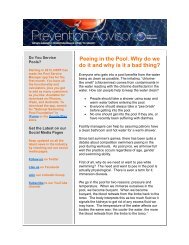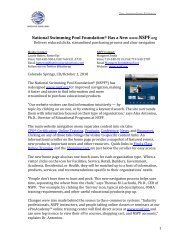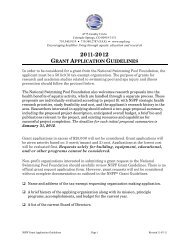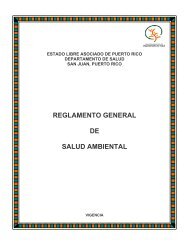English Instructor Manual (PDF) - Metric Version - National ...
English Instructor Manual (PDF) - Metric Version - National ...
English Instructor Manual (PDF) - Metric Version - National ...
You also want an ePaper? Increase the reach of your titles
YUMPU automatically turns print PDFs into web optimized ePapers that Google loves.
Chapter 1 – Risk Management for RWIs<br />
Chapter: Chapter 1 (pages 1-7)<br />
Suggested Time:<br />
PowerPoint Slides:<br />
Materials:<br />
30 minutes<br />
RWI Chapter 1 PowerPoint Slides<br />
Recreational Water Illnesses Handbook<br />
Objectives: At the end of this chapter the student will be able to:<br />
List three reasons people are attracted to aquatic facilities<br />
Explain the steps associated with a systems approach to the allocation of funds for risk<br />
management<br />
Explain what is meant by hazard identifi cation, dose response and exposure<br />
assessment as they relate to risk assessment<br />
Explain why a risk management plan must be adjusted for groups, such as competitive<br />
swimmers, lifeguards and toddlers using wading pools<br />
Leading Questions:<br />
Why are people attracted to aquatic facilities?<br />
What is risk management?<br />
Why is management of aquatic risks important to an operator?<br />
Key Points: Briefl y discuss the purpose of risk management as it relates to aquatic facilities. (pp.<br />
2-3). Include the following:<br />
Reasons people are attracted to aquatic facilities<br />
Methods for ensuring the health and safety of patrons and staff<br />
Steps in a systems approach to risk management<br />
Key Points: Explain what is meant by risk assessment and the factors that infl uence the severity<br />
of a potential risk (p. 3-6). Include information relative to:<br />
Hazard Identifi cation<br />
Potential causes of illness<br />
Dose Response Analysis<br />
Potential complications in determining an accurate dose response<br />
Exposure Assessment<br />
Methods of exposure (skin, ingestion, inhalation)<br />
Key Points: Risk assessment in special groups (p 6). Include information relative to:<br />
Potential high risk groups<br />
Lifeguards<br />
Competitive swimmers<br />
Toddlers<br />
© 2014 <strong>National</strong> Swimming Pool Foundation® Page 149



